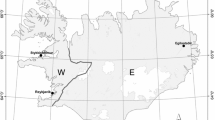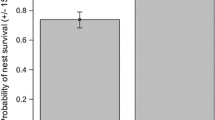Summary
The relationship between local density of adult periodical cicadas (Magicicada septendecim) and fecundity was investigated at 3 sites in 1979 and 6 sites in 1980. In 1979, a sample taken 9 days after the emergence peak showed no significant differences in the number of vitellogenic follicles contained by females from the three sites. A later sample, taken 22 days after the emergence peak, revealed significant between-site differences in the number of follicles per female. Individuals from the densest site contained over 50% more follicles than females from the lowest density site. In 1980, there was again a significant between-site difference in fecundity. Females from sites of higher density contained more follicles than females from less dense sites.
The rate at which females mated was independent of local adult density. At all sites, most females had successfully mated by the end of the emergence period. All females required at least 5 days and usually longer before mating and ovipositing.
Earlier work demonstrated that the ratio of offspring: adults was greater at sites of higher emergence density than at low lensity sites. The pattern of inverse density-dependent fecundity, reported here, undoubtedly contributes to this effect. However, density dependent mating speed does not appear to contribute to this effect.
Similar content being viewed by others
References
Alexander RD, Moore TE (1958) Studies on the acoustical behavior of seventeen-year cicadas. (Homoptera/Cicadidae: Magicicada). Ohio J Sci Food Agric 58:107–127
Alexander RD, Moore TE (1962) The evolutionary relationships of 17-year and 13-year cicadas, and three new species (Homoptera: Cicadidae: Magicicada). Misc Publ Mus Zool Univ Mich 121:1–59
Borgia G (1978) Sexual selection and the evolution of mating systems In: Blum MS, Blum NA (eds) Sexual selection and reproductive competition in insects. Academic Press, New York
Brower LP, Brower JVZ, Cranston FP (1965) Courtship behavior in the queen butterfly, Danaus gilipus berenice (Cramer). Zoologica 50:1–39
Brown JJ, Chippendale GM (1973) Nature and fate of the nutrient reserves of the periodical (17 years) cicada. J Insect Physiol 19:607–614
Carrow JR, Betts RE (1973) Effects of different foliar-applied nitrogen fertilizers on Balsam Wooly Aphid. Can J For Res 3:122–139
Cheng CH, Pathak MD (1972) Resistance to Nephotettix virescens in rice varieties. J Econ Entomol 65:1148–1153
Dybas HS, Davis DD (1962) A population census of seventeen-year periodical cicadas (Homoptera: Cicadidae: Magicicada). Ecology 43:432–444
Engelmann F (1970) The physiology of insect reproduction. Pergamon Press, Oxford
Hickernell LM (1923) The digestive system of the periodical cicada, Tibicen septendecim. Linn III. Morphology of the system in the nymph. Biol Bull 45:213–229
Karban R (1981) Flight and dispersal of periodical cicadas. Oecologia (Berl.) 49:385–390
Karban R (1982) Increased reproductive success at high densities and predator satiation for periodical cicadas Ecology 63: in press
Kennedy JS, Booth CO (1951) Host alternation in Aphis fabae. 1. Feeding preferences and fecundity in relation to the age and kind of leaves. Ann Appl Biol 38:25–64
Labeyrie V (1978) The significance of the environment in the control of insect fecundity. Ann Rev Entom 23:69–89
Lack D (1968) Ecological adaptations for breeding birds. Methuen, London
Lloyd M, Dybas HS (1966) The periodical cicada problem. I. Population ecology. Evolution 20:133–149
Lloyd M, Dybas HS (1966) The periodical cicada problem. II. Evolution. Evolution 20:466–505
Maier CT (1980) A mole's-eye view of seventeen-year periodical cicada nymphs, Magicicada septendecim (Hemiptera: Homoptera: Cicadidae). Ann Ent Soc Amer 73:147–152
Marlatt CL (1907) The periodical cicada. Bull. USDA Bur Entomol 71:1–181
McClure MS (1980) Foliar nitrogen: a basis for host suitability for elongate hemlock scale, Fiorinia externa (Homoptera: Diaspididae) Ecology 61:72–79
Nishigaki J (1963) The effect of low population density on the mating chance and the fecundity of the azuki bean weevil, Callosobruchus chinensis. Jpn J Ecol 13:178–184
Sogawa K (1971) Feeding behavior of the brown leafhopper and varietal resistance of rice to this insect. In: Symposium on Rice Insects Proc Samp on Tropical Agric Res
Trivers RL (1972) Parental investment and sexual selection. In: Campbell B (ed) Sexual selection and the descent of man. Aldine, Chicago
Warner RR, Hoffman SG (1980) Local population size as a determinant of mating system and sexual composition in two tropical marine fishes (Thalassoma spp). Evolution 34:508–518
White JA (1973) Viable hybrid young from cross-mated periodical cicadas. Ecology 54:573–580
White JA, Lloyd M (1975) Growth rates of 17- and 13-year periodical cicadas. Amer Midl Nat 94:127–143
White JA, Strehl CE (1978) Xylem feeding by periodical cicada nymphs on tree roots. Ecol Entom 3:323–327
White JA, Lloyd M, Zar JH (1979) Faulty eclosion in crowded suburban periodical cicadas: populations out of control. Ecology 60:305–315
Whitham TG (1980) The theory of habitat selection: examined and extended using Pemphigus aphids. Amer Nat 115:449–466
Author information
Authors and Affiliations
Rights and permissions
About this article
Cite this article
Karban, R. Effects of local density on fecundity and mating speed for periodical cicadas. Oecologia 51, 260–264 (1981). https://doi.org/10.1007/BF00540611
Received:
Issue Date:
DOI: https://doi.org/10.1007/BF00540611




